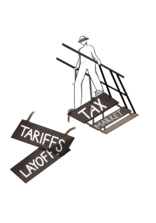
In today’s America, science is under siege. From gutted research budgets to the silencing of vital health data, the institutions that power innovation and save lives are struggling to stay afloat.
Upon taking office, President Donald Trump pulled billions of dollars from scientific research and health initiatives, impacting federal agencies, universities and medical organizations. By the end of January, the Centers for Disease Control and Prevention removed key databases and censored research papers, including data on HIV statistics and teen health. A temporary rollback restored access to some information weeks later.
”Public trust in science has already been decreasing,” said senior Noah Lin. “There [are] people who will trust an influencer online over medical study, simply because it either conforms with their beliefs or they want to feel different. And if we get … less public funding, it might push researchers to publish information that might not be as heavily vetted.”
The National Science Foundation saw a partial unfreezing of funds in early February, but soon after, National Institutes of Health research overhead funding was slashed from 40% to 15%. Numerous universities, from Stanford University to North Carolina State, have been affected by hiring freezes, reduced PhD admissions and cuts to financial aid. The Trump Administration’s defunding of these agencies and more is being contested in court by legal experts, who claim it violates the will of Congress, in the case of NIH, or that it violates free speech, in the case of universities.
“It’s a goal … [for] a lot of people I know to apply for scholarships,” said junior Dahlia Anapolsky. “College is expensive. It’s hard to pay for … and lack of funding for scholarships is harmful because some people that want to go to college will have to take a little back seat or take out loans or not be able to have freedom when they go there.”
The funding cuts have also impacted patients dependent on research-driven treatments. For those in early clinical trials with few treatment options, the loss of funding could be a death sentence.
While the cuts pose an immediate threat to patient care, the broader impact hinders Science, Technology, Engineering and Math advancement in America. Scientists don’t feel safe to do accurate research under the current administration. For instance, Dr. Marc Ruel, a world-renowned heart surgeon, declined the Chief of the Division of Adult Cardiothoracic Surgery position at the University of California, San Francisco, citing concerns over the evolving political climate in the U.S.
The administration also announced plans to cut over 10,000 workers from the U.S. Agency for International Development. By mid-February, layoffs within the NIH, CDC and National Science Foundation became widespread.
“Some of my friends who work in natural resource management and the National Park Service got termination letters,” said Katherine Ward, Advanced Placement Biology and Biotechnology teacher. “These are people … checking [for] avalanche problems [and] rock slides … [They’re] being told that they were being fired because they were incompetent … They feel demoralized, they feel lied to, they feel betrayed. If you want to downsize the government, that’s fine, but don’t do it in a dishonest way.”
The U.S. withdrawal from the World Health Organization and the Paris Climate Agreement, along with proposed cuts to climate research and clean-energy investments under Project 2025, signals a shift in national priorities. With science increasingly constrained by political ideology, concerns arise about its future alongside global innovation.
“It is absolutely motivation for other countries to develop their own scientific power whether it’s for nuclear power and nuclear weaponry or drug development and drug discovery,” Ward said. “It is absolutely a call to arms for every other country on the globe to start putting more dollars into their … own research. That can only mean that it’s going to get more competitive, and that may be to our detriment.”
The administration also dismantled diversity initiatives, enforcing a rigid definition of biological sex and restricting grants referencing race, disability or gender studies.
“There’s a very small minority … making their voices very loud and projecting their thoughts onto others that are in control right now,” Anapolsky said. “I wouldn’t say it reflects the country as a whole, but we live in this bubble [in the Bay Area]. Everyone around us doesn’t agree with it, but it’s hard to say how people outside of it do.”
As funding and staffing cuts continue in critical sectors and politics reshape academia, the future of U.S. science and education remains uncertain.



